Omron CJ2 CPU User Manual

Cat. No. W472-E1-07
SYSMAC CJ Series
CJ2H-CPU6@-EIP CJ2H-CPU6@ CJ2M-CPU@@
CJ2 CPU Unit Hardware
USER’S MANUAL
OMRON, 2008
All rights reserved. No part of this publication may be reproduced, stored in a retrieval system, or transmitted, in any form, or by any means, mechanical, electronic, photocopying, recording, or otherwise, without the prior written permission of OMRON.
No patent liability is assumed with respect to the use of the information contained herein. Moreover, because OMRON is constantly striving to improve its high-quality products, the information contained in this manual is subject to change without notice. Every precaution has been taken in the preparation of this manual. Nevertheless, OMRON assumes no responsibility for errors or omissions. Neither is any liability assumed for damages resulting from the use of the information contained in this publication.
SYSMAC CJ Series
CJ2H-CPU6@-EIP CJ2H-CPU6@ CJ2M-CPU@@
CJ2 CPU Unit Hardware
User’s Manual
Revised July 2010
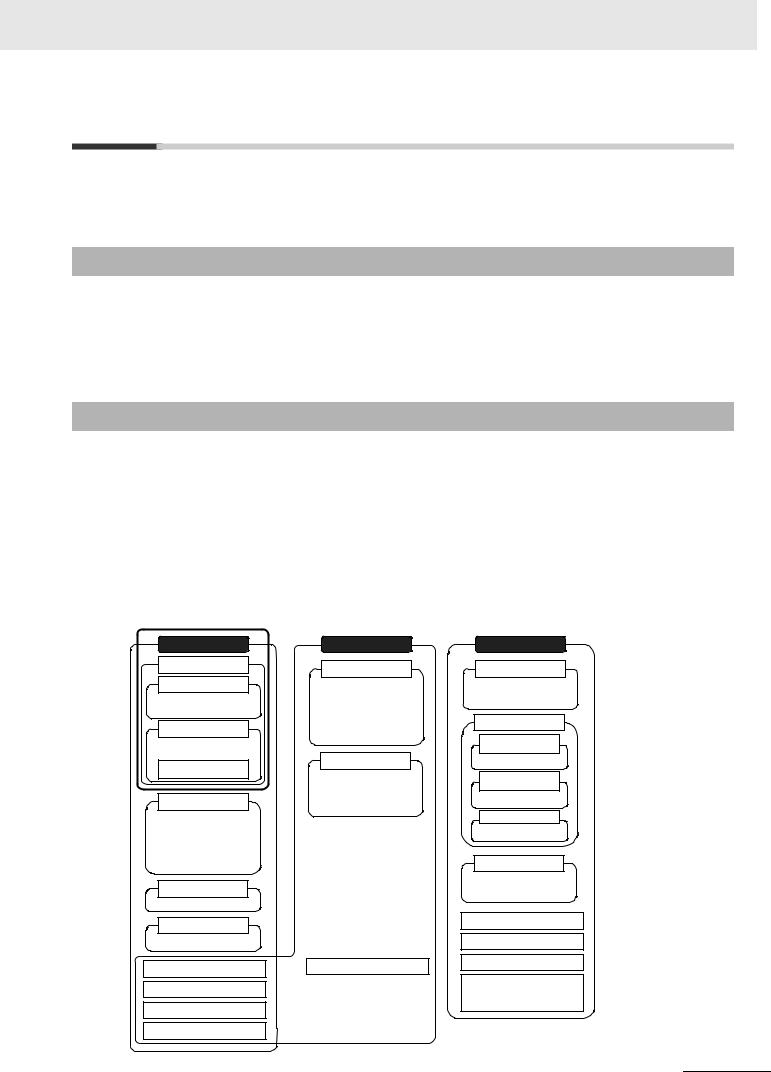
Introduction
Thank you for purchasing a CJ-series CJ2H-CPU6@(-EIP) or CJ2M-CPU@@ Programmable Controller. This manual contains information required to use the CJ2H-CPU6@(-EIP) and CJ2M-CPU@@. Please thoroughly read and understand this manual before you use the CJ2H-CPU6@(-EIP).
Intended Audience
This manual is intended for the following personnel, who must also have knowledge of electrical systems (an electrical engineer or the equivalent).
•Personnel in charge of installing FA systems
•Personnel in charge of designing FA systems.
•Personnel in charge of managing FA systems and facilities.
Applicable Products
CJ-series CJ2 CPU Units
•CJ2H-CPU6@-EIP
•CJ2H-CPU6@
•CJ2M-CPU3@
•CJ2M-CPU1@
In this manual, the following notation is used to indicate the CPU Units.
•CJ2H-CPU6@(-EIP): Indicates the CJ2H-CPU6@-EIP and CJ2H-CPU6@ CPU Units.
•CJ2M-CPU@@: Indicates the CJ2M-CPU3@ and CJ2M-CPU1@ CPU Units.
Optional Pulse I/O Modules can be used for pulse I/O with a CJ2M CPU Unit.
CJ2 Series
CJ2 CPU Units
CJ2H CPU Units
CJ2H-CPU6@-EIP
CJ2H-CPU6@
CJ2M CPU Units
CJ2M-CPU3@
CJ2M-CPU1@
Pulse I/O Module for
CJ2M CPU Units
CJ1-H CPU Units
CJ1H-CPU@@H-R CJ1H-CPU@@H CJ1G-CPU@@H CJ1G -CPU@@P (Loop CPU Units)
CJ1M CPU Units
CJ1M-CPU@@
CJ1 CPU Units
CJ1G-CPU@@
CJ-series Basic I/O Units
CJ-series Special I/O Units
CJ-series CPU Bus Units
NSJ Series
NSJ Controllers
NSJ5-TQ@@(B)-G5D NSJ5-SQ@@(B)-G5D NSJ8-TV@@(B)-G5D NSJ10-TV@@(B)-G5D NSJ12-TS@@(B)-G5D
NSJ Controllers
NSJ5-TQ@@(B)-M3D
NSJ5-SQ@@(B)-M3D
NSJ8-TV@@(B)-M3D
NSJ-series Expansion Units
CS Series
CS1-H CPU Units
CS1H-CPU@@H
CS1G-CPU@@H
CS1D CPU Units
CS1D CPU Units for Duplex Systems
CS1D-CPU@@H
CS1D CPU Units for Simplex Systems
CS1D-CPU@@S
CS1D Process-control CPU Units
CS1D-CPU@@P
CS1 CPU Units
CS1H-CPU@@(-V)
CS1G-CPU@@(-V)
CS-series Basic I/O Units
CS-series Special I/O Units
CS-series CPU Bus Units
CS-series Power Supply Units
Note: A special Power Supply Unit must be used for CS1D CPU Units.
CJ-series Power Supply Units
CJ2 CPU Unit Hardware User’s Manual |
1 |
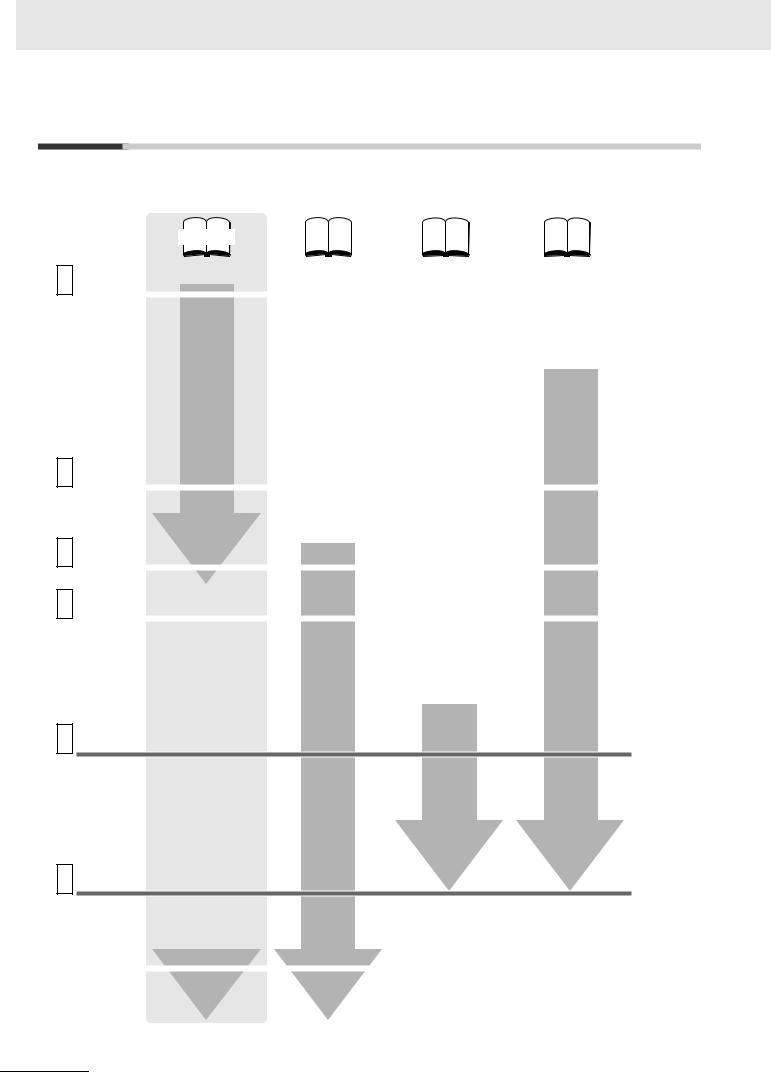
CJ2 CPU Unit Manuals
Information on the CJ2 CPU Units is provided in the following manuals. Refer to the appropriate manual for the information that is required.
1
2
This Manual
Mounting
and Setting |
CJ-series CJ2 CPU Unit |
CJ-series CJ2 CPU Unit |
CS/CJ/NSJ Series |
CJ2M CPU Unit Pulse |
|
Hardware User’s Manual |
Software User’s Manual |
Instructions Reference |
I/O Module User's |
||
Hardware |
(Cat. No. W472) |
(Cat. No. W473) |
Manual (Cat. No. W474) |
Manual (Cat. No. W486) |
|
|
|
|
|
|
|
|
• Unit part names and |
|
|
|
|
|
• |
specifications |
|
|
|
|
Basic system |
|
|
|
|
|
• |
configuration |
|
|
|
|
Unit mounting |
|
|
|
|
|
• |
procedure |
|
|
|
|
Setting procedure for |
|
|
|
|
|
|
DIP switch and rotary |
|
• |
Specifications and wiring |
|
|
switches on the front of |
|
||
|
|
|
|
of Pulse I/O Modules |
|
|
|
the CPU Unit |
|
• |
|
|
|
|
Available pulse I/O |
||
|
|
|
|
||
|
For details on built-in |
functions and allocations |
|
EtherNet/IP port, refer to |
|
|
|
|
|
the EtherNet/IP Unit |
|
Wiring |
Operation Manual (W465) |
|
|
|
|
|
|
|
3
4
|
• |
Wiring the Power |
• |
Pulse I/O Module |
Connecting • |
Supply Unit |
• |
specifications |
|
Wring Basic I/O Units |
Wiring methods between |
|||
Online to |
|
and external I/O |
|
Pulse I/O Modules and |
|
devices |
|
external I/O devices |
|
the PLC |
|
|
||
|
|
|
|
|
|
|
|
|
|
Software |
CX-Programmer Support |
Procedures for connecting |
|
|
Software Connecting |
the CX-Programmer |
|
||
Setup |
Cables |
Support Software |
|
|
|
|
|
|
|
5
6
Creating the
Program
Software setting methods for the CPU Unit (including I/O memory allocation, PLC Setup settings, Special I/O Unit parameters, CPU Bus Unit parameters, and routing tables.)
For details on built-in EtherNet/IP port, refer to the EtherNet/IP Unit Operation Manual (W465).
Software setting procedures for Pulse I/O Modules (I/O memory allocations and PLC Setup settings)
Checking and Debugging Operation
•Program types and basic information
•CPU Unit operation
•Internal memory
•Data management using file memory in the CPU Unit
•Built-in CPU functions
•Settings
Detailed information |
Pulse I/O functions |
on programming |
|
instructions |
|
|
|
|
|
|
• Checking I/O wiring, setting the |
|
|
Maintenance |
Auxiliary Area settings, and |
||
|
|
performing trial operation |
|||
7 |
|
and |
|
|
• Monitoring and debugging with |
Troubleshooting |
|
|
the CX-Programmer |
||
|
|||||
|
|
|
|
||
|
|
Error codes and |
|
||
|
|
remedies if a problem |
|
||
|
|
occurs |
|
||
2 |
CJ2 CPU Unit Hardware User’s Manual |

Manual Configuration
The CJ2 CPU manuals are organized in the sections listed in the following tables. Refer to the appropriate section in the manuals as required.
Hardware User’s Manual (Cat. No. W472) (This Manual)
Section |
Content |
|
Section 1 Overview |
This section gives an overview of the CJ2 CPU Units and describes the features and |
|
specifications. |
||
|
||
Section 2 Basic System Configu- |
This section describes the system configuration for the CJ2 CPU Unit. |
|
ration and Devices |
|
|
Section 3 Nomenclature and |
This section describes the part names and functions of the CPU Unit and Configuration |
|
Functions |
Units. |
|
Section 4 Support Software |
This section describes the types of Support Software to use to perform programming and |
|
debugging and how to connect the PLC to the Support Software. |
||
|
||
Section 5 Installation |
This section describes the installation locations and how to wire CPU Units and Configu- |
|
ration Units. |
||
|
||
Section 6 Troubleshooting |
This section describes how to check the status for errors that occur during system opera- |
|
tion and the remedies for those errors. |
||
|
||
Section 7 Inspection and Mainte- |
This section describes periodic inspection, the service life of the Battery and Power Sup- |
|
nance |
ply Unit, and how to replace the Battery. |
|
Section 8 Backup Operations |
This section describes the procedure to back up PLC data. |
|
|
The appendices provide Unit dimensions, details on fatal and non-fatal errors, informa- |
|
Appendices |
tion on connecting to serial ports on the CPU Unit, the procedure for installing the USB |
|
driver on a computer, and information on load short-circuit protection and line disconnec- |
||
|
||
|
tion detection. |
|
|
|
Software User’s Manual (Cat. No. W473)
Section |
Content |
|
Section 1 Overview |
This section gives an overview of the CJ2 CPU Units and describes the features and |
|
specifications. |
||
|
||
|
|
|
Section 2 Internal Memory in the |
This section describes the types of memory in the CPU Unit and the data that is stored. |
|
CPU Unit |
|
|
|
|
|
Section 3 CPU Unit Operation |
This section describes the internal operation of the CPU Unit. |
|
|
|
|
Section 4 CPU Unit Initialization |
This section describes the initial setup of the CPU Unit. |
|
|
|
|
Section 5 Understanding Pro- |
This section describes program types and programming details, such as symbols and |
|
gramming |
programming instructions. |
|
|
|
|
Section 6 I/O Memory Areas |
This section describes the I/O memory areas in the CPU Unit. |
|
|
|
|
Section 7 File Operations |
This section describes the files that can be stored in the CPU Unit, the storage destina- |
|
tion for those files, and file operations. |
||
|
||
|
|
|
Section 8 I/O Allocations and |
This section describes the I/O allocations used to exchange data between the CPU Unit |
|
Unit Settings |
and other Units. |
|
|
|
|
Section 9 PLC Setup |
This section describes details on the PLC Setup settings, which are used to perform |
|
basic settings for the CPU Unit. |
||
|
||
|
|
|
Section 10 CPU Unit Functions |
This section describes functions that are built into the CPU Unit. |
|
|
|
|
Section 11 Programming Devices |
This section describes the procedure for connecting the CJ2 CPU Unit to the CX-Pro- |
|
and Communications |
grammer or other Support Software and to other devices. |
|
|
|
|
Section 12 CPU Unit Cycle Time |
This section describes how to monitor and calculate the cycle time. |
|
|
|
|
|
The appendices provide information on programming instructions, execution times, num- |
|
Appendices |
ber of steps, Auxiliary Area words and bits, a memory map of the continuous PLC mem- |
|
ory addresses, I/O memory operation when power is interrupted, and a comparison of |
||
|
||
|
CJ-series and CS-series PLCs. |
|
|
|
CJ2 CPU Unit Hardware User’s Manual |
3 |

Instructions Reference Manual (Cat. No. W474)
|
Section |
Content |
|
Section 1 Basic Understanding |
This section provides basic information on designing ladder programs for a CS/CJ/NSJ- |
||
of Instructions |
series CPU Unit. |
||
|
|
|
|
Section 2 |
Summary of Instruc- |
This section provides a summary of instructions used with a CS/CJ/NSJ-series CPU |
|
tions |
|
Unit. |
|
|
|
|
|
Section 3 |
Instructions |
This section describes the functions, operands and sample programs of the instructions |
|
that are supported by a CS/CJ/NSJ-series CPU Unit. |
|||
|
|
||
|
|
|
|
Section 4 |
Instruction Execution |
This section provides the instruction execution times for each CS/CJ/NSJ-series CPU |
|
Times and Number of Steps |
Unit instruction. |
||
|
|
|
|
Appendices |
The appendices provide a list of instructions by function code and by mnemonic and an |
||
ASCII table for the CS/CJ/NSJ-series CPU Units. |
|||
|
|
||
|
|
|
|
Pulse I/O Module User's Manual (Cat. No. W486)
Section |
Content |
|
Section 1 Overview |
This section gives an overview of the Pulse I/O Modules and the pulse I/O functions of |
|
the CJ2M. |
||
|
||
|
|
|
Section 2 I/O Application Proce- |
This section lists the pulse functions of the CJ2M CPU Units and describes the overall |
|
dures and Function Allocations |
application flow and the allocation of the functions. |
|
|
|
|
Section 3 I/O Specifications and |
This section provides the I/O specifications and describes the wiring of the Pulse I/O |
|
Wiring for Pulse I/O Modules |
Module. |
|
|
|
|
Section 4 General-purpose I/O |
This section describes the general-purpose I/O. |
|
|
|
|
Section 5 Quick-response Inputs |
This section describes the quick-response function that can be used to input signals that |
|
are shorter than the cycle time. |
||
|
||
|
|
|
Section 6 Interrupts |
This section describes the interrupt input function. |
|
|
|
|
Section 7 High-speed Counters |
This section describes the high-speed counter inputs and high-speed counter interrupts. |
|
|
|
|
Section 8 Pulse Outputs |
This section describes positioning functions, such as trapezoidal control, S-curve control, |
|
jogging, and origin search functions. |
||
|
||
|
|
|
Section 9 PWM Outputs |
This section describes the variable-duty-factor (PWM) outputs. |
|
|
|
|
Appendices |
The appendices provide a table of flag changes for pulse outputs, a comparison table |
|
with other models, and a performance table. |
||
|
||
|
|
4 |
CJ2 CPU Unit Hardware User’s Manual |
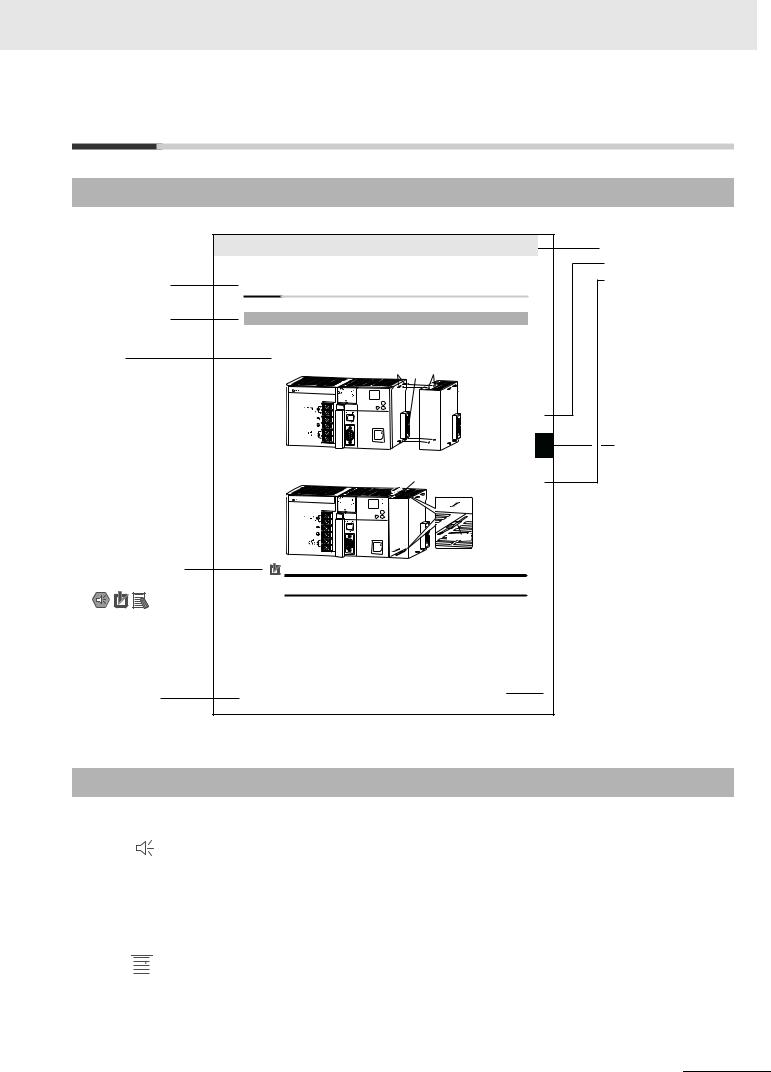
Manual Structure
Page Structure
The following page structure is used in this manual.
Level 2 heading
Level 3 heading
A step
in a procedure
Special Information (See below.)
5 Installation
5-2 Installation
5-2-1 Connecting PLC Components
The Units that make up a CJ-series PLC can be connected simply by pressing the Units together and locking the sliders by moving them toward the back of the Units. The End Cover is connected in the same way to the Unit on the far right side of the PLC.
1. Join the Units so that the connectors fit exactly.
Hook |
Hook holes |
|
Connector |
|
|
|
|
2-5 |
|
|
noitallatsnI |
|
|
5 |
2. The yellow sliders at the top and bottom of each Unit lock the Units together. Move the sliders |
5 |
|
toward the back of the Units as shown below until they click into place. |
1-2- |
|
|
Move the sliders toward the back |
oC |
|
until they lock into place. |
nn |
|
Lock |
P gnitce |
|
Release |
C CL |
|
Slider |
stnenopmo |
|
|
|
 Precautions for Correct Use
Precautions for Correct Use
If the locking tabs are not secured properly, the connectors may become loose and not function properly. Be sure to slide the locking tabs until they are securely in place.
Level 1 heading
Level 2 heading
Level 3 heading
Gives the current headings.
Page tab
Gives the number of the section.
Manual name
CJ2 CPU Unit Hardware User’s Manual |
5-13 |
This illustration is provided only as a sample and may not literally appear in this manual.
Special Information
Special information in this manual is classified as follows:
 Precautions for Safe Use
Precautions for Safe Use
Precautions on what to do and what not to do to ensure using the product safely.
 Precautions for Correct Use
Precautions for Correct Use
Precautions on what to do and what not to do to ensure proper operation and performance.


 Additional Information
Additional Information
Additional information to increase understanding or make operation easier.
CJ2 CPU Unit Hardware User’s Manual |
5 |
|
|
|
|
|
|
|
6 |
CJ2 CPU Unit Hardware User’s Manual |

Sections in this Manual
1 |
Overview |
|
|
|
|
2 |
Basic System Configuration and Devices |
|
|
|
|
3 |
Nomenclature and Functions |
|
|
|
|
4 |
Support Software |
|
|
|
|
5 |
Installation |
|
|
|
|
6 |
Troubleshooting |
|
|
|
|
7 |
Inspection and Maintenance |
|
|
|
|
8 |
Backup Operations |
|
|
|
|
A |
Appendices |
|
|
1
2
3
4
5
6
7
8
A
CJ2 CPU Unit Hardware User’s Manual |
7 |
|
|
|
|
|
|
|
8 |
CJ2 CPU Unit Hardware User’s Manual |

CONTENTS
Introduction............................................................................................................... |
1 |
CJ2 CPU Unit Manuals ............................................................................................. |
2 |
Manual Structure ...................................................................................................... |
5 |
Sections in this Manual............................................................................................ |
7 |
Safety Precautions ................................................................................................. |
17 |
Application Precautions......................................................................................... |
21 |
Operating Environment Precautions .................................................................... |
26 |
Regulations and Standards ................................................................................... |
27 |
Unit Versions of CJ2 CPU Units ............................................................................ |
29 |
Related Manuals ..................................................................................................... |
35 |
Section 1 |
|
Overview |
|
|
|
|
|
|
|
1-1 |
Overview of CJ2 CPU Units .................................................................................................... |
1-2 |
||
|
|
1-1-1 |
Overview..................................................................................................................................... |
1-2 |
|
|
1-1-2 |
CJ2 CPU Unit Features .............................................................................................................. |
1-4 |
1-2 |
Basic Operating Procedure .................................................................................................. |
1-12 |
||
1-3 |
Specifications ........................................................................................................................ |
1-13 |
||
|
|
1-3-1 |
General Specifications.............................................................................................................. |
1-13 |
|
|
1-3-2 |
Performance Specifications ...................................................................................................... |
1-14 |
|
|
1-3-3 |
Function Specifications............................................................................................................. |
1-21 |
Section 2 |
|
Basic System Configuration and Devices |
|
|
|
|
|
|
|
2-1 |
Basic System Configuration................................................................................................... |
2-2 |
||
|
|
2-1-1 |
Basic System Configuration........................................................................................................ |
2-2 |
|
|
2-1-2 |
CPU Rack ................................................................................................................................... |
2-3 |
|
|
2-1-3 |
Expansion Racks ...................................................................................................................... |
2-11 |
|
|
2-1-4 |
Configuration Units ................................................................................................................... |
2-14 |
|
|
2-1-5 Calculating Unit Current Consumption ..................................................................................... |
2-22 |
|
|
|
2-1-6 |
Calculating Power Consumption............................................................................................... |
2-25 |
2-2 |
Expanded System Configuration ......................................................................................... |
2-27 |
||
|
|
2-2-1 |
Serial Communications............................................................................................................. |
2-27 |
|
|
2-2-2 |
Communications Networks ....................................................................................................... |
2-29 |
CJ2 CPU Unit Hardware User’s Manual |
9 |

Section 3 |
|
Nomenclature and Functions |
|
|
|
|
|
|
|
3-1 |
CPU Units ................................................................................................................................. |
3-2 |
||
|
|
3-1-1 |
CPU Section................................................................................................................................ |
3-2 |
|
|
3-1-2 |
Built-in EtherNet/IP Section (CJ2H-CPU6@-EIP and CJ2M-CPU3@ Only) ............................... |
3-8 |
3-2 |
Memory Card.......................................................................................................................... |
3-13 |
||
|
|
3-2-1 |
Models and Specifications ........................................................................................................ |
3-13 |
|
|
3-2-2 |
Operating Procedures ............................................................................................................... |
3-13 |
|
|
3-2-3 |
Installing and Removing............................................................................................................ |
3-14 |
|
3-3 Pulse I/O Modules (CJ2M CPU Unit Only) ........................................................................... |
3-17 |
||
|
|
3-3-1 |
Models and Specifications ........................................................................................................ |
3-17 |
|
|
3-3-2 |
Part Names and Functions........................................................................................................ |
3-17 |
|
3-4 Serial Option Boards (CJ2M-CPU3@ Only) ......................................................................... |
3-20 |
||
|
|
3-4-1 |
Overview ................................................................................................................................... |
3-20 |
3-5 |
Power Supply Units ............................................................................................................... |
3-21 |
||
|
|
3-5-1 |
Models and Specifications ........................................................................................................ |
3-21 |
|
|
3-5-2 |
Components.............................................................................................................................. |
3-24 |
|
|
3-5-3 |
Selecting a Power Supply Unit .................................................................................................. |
3-27 |
|
3-6 CJ-series Basic I/O Units ...................................................................................................... |
3-28 |
||
|
|
3-6-1 |
Basic I/O Units with Terminal Blocks......................................................................................... |
3-28 |
|
|
3-6-2 |
Thirty-two/Sixty-four-point Basic I/O Units with Connectors...................................................... |
3-30 |
|
3-7 I/O Control Units and I/O Interface Units ............................................................................. |
3-32 |
||
|
|
3-7-1 |
Component Names ................................................................................................................... |
3-32 |
|
|
3-7-2 |
System Configuration................................................................................................................ |
3-32 |
Section 4 |
|
Support Software |
|
|
|
|
|
|
|
4-1 |
Support Software..................................................................................................................... |
4-2 |
||
|
|
4-1-1 CX-One FA Integrated Tool Package .......................................................................................... |
4-2 |
|
4-2 |
Connection Methods ............................................................................................................... |
4-5 |
||
|
|
4-2-1 |
Connecting by USB..................................................................................................................... |
4-5 |
|
|
4-2-2 |
Connecting by RS-232C ............................................................................................................. |
4-7 |
|
|
4-2-3 |
Connecting to Ethernet (CJ2H-CPU6@-EIP and CJ2M-CPU3@ Only) ...................................... |
4-9 |
Section 5 |
|
Installation |
|
|
|
|
|
|
|
5-1 |
Fail-safe Circuits...................................................................................................................... |
5-2 |
||
5-2 |
Installation................................................................................................................................ |
5-4 |
||
|
|
5-2-1 |
Installation and Wiring Precautions............................................................................................. |
5-4 |
|
|
5-2-2 |
Installation in a Control Panel ..................................................................................................... |
5-6 |
|
|
5-2-3 |
Assembled Appearance and Dimensions ................................................................................... |
5-8 |
|
|
5-2-4 |
Connecting PLC Components................................................................................................... |
5-13 |
|
|
5-2-5 |
DIN Track Installation ................................................................................................................ |
5-15 |
|
|
5-2-6 |
Connecting CJ-series Expansion Racks ................................................................................... |
5-17 |
5-3 |
Wiring ..................................................................................................................................... |
5-20 |
||
|
|
5-3-1 |
Power Supply Wiring ................................................................................................................. |
5-20 |
|
|
5-3-2 |
Wiring CJ-series Basic I/O Units with Terminal Blocks ............................................................. |
5-27 |
|
|
5-3-3 |
Wiring Basic I/O Units with Connectors .................................................................................... |
5-29 |
|
|
5-3-4 |
Connecting to Connector-Terminal Block Conversion Units or I/O Relay Terminals ................. |
5-33 |
|
|
5-3-5 |
Connecting Pulse I/O Modules to External I/O Devices (CJ2M CPU Unit Only)....................... |
5-33 |
|
|
5-3-6 |
Connecting I/O Devices ............................................................................................................ |
5-35 |
|
|
5-3-7 |
Connecting through an Ethernet Cable (CJ2H-CPU6@-EIP and CJ2M-CPU3@ Only)............ |
5-39 |
10 |
CJ2 CPU Unit Hardware User’s Manual |

5-4 Control Panel Installation ..................................................................................................... |
5-42 |
|
5-4-1 |
Temperature.............................................................................................................................. |
5-42 |
5-4-2 |
Humidity.................................................................................................................................... |
5-44 |
5-4-3 |
Vibration and Shock.................................................................................................................. |
5-44 |
5-4-4 |
Atmosphere .............................................................................................................................. |
5-44 |
5-4-5 |
Electrical Environment .............................................................................................................. |
5-45 |
5-4-6 |
Grounding ................................................................................................................................. |
5-50 |
Section 6 |
Troubleshooting |
|
|
|
|
|
|
|
6-1 CPU Unit Errors ....................................................................................................................... |
6-2 |
|
6-1-1 |
Errors and Remedies.................................................................................................................. |
6-2 |
|
6-1-2 |
Checking Errors .......................................................................................................................... |
6-2 |
|
6-1-3 |
Checking Detailed Status ........................................................................................................... |
6-3 |
|
6-1-4 |
Reading Error Log Information ................................................................................................... |
6-3 |
|
6-1-5 |
I/O Table Verification................................................................................................................... |
6-5 |
|
6-1-6 |
Types of Errors............................................................................................................................ |
6-6 |
|
6-1-7 |
Handling Errors........................................................................................................................... |
6-7 |
|
|
6-2 Troubleshooting Built-in EtherNet/IP Port Errors |
|
|
|
(CJ2H-CPU6@-EIP and CJ2M-CPU3@ Only)........................................................................ |
6-25 |
|
6-2-1 |
Checking Built-in EtherNet/IP Port Error Status ....................................................................... |
6-25 |
|
6-2-2 |
Checking Error Status at the EtherNet/IP Port Seven-segment Display................................... |
6-26 |
|
|
6-3 Non-CPU Unit Errors and Remedies.................................................................................... |
6-28 |
|
6-3-1 |
Error Causes and Remedies .................................................................................................... |
6-28 |
|
Section 7 |
|
Inspection and Maintenance |
|
|
|
|
|
|
|
7-1 |
Inspections............................................................................................................................... |
7-2 |
||
|
|
7-1-1 |
Inspection Points ........................................................................................................................ |
7-2 |
|
|
7-1-2 |
Unit Replacement Precautions ................................................................................................... |
7-4 |
7-2 |
Replacing the Battery.............................................................................................................. |
7-5 |
||
|
|
7-2-1 |
Battery Replacement .................................................................................................................. |
7-5 |
|
|
7-2-2 |
Operation When Battery Is Exhausted or Not Installed .............................................................. |
7-8 |
7-3 |
Power Supply Unit Replacement Time ................................................................................ |
7-10 |
||
Section 8 |
|
Backup Operations |
|
|
|
|
|
|
|
8-1 |
Backing Up Data ...................................................................................................................... |
8-2 |
||
8-2 |
Using a Computer to Back Up Data ....................................................................................... |
8-3 |
||
|
|
8-2-1 |
PLC Backup Tool ........................................................................................................................ |
8-3 |
|
|
8-2-2 |
PLC Backup Tool Operations...................................................................................................... |
8-4 |
8-3 |
Simple Backup......................................................................................................................... |
8-7 |
||
|
|
8-3-1 |
Overview..................................................................................................................................... |
8-7 |
|
|
8-3-2 |
Operating Procedures................................................................................................................. |
8-8 |
|
|
8-3-3 |
Verifying Backup Operations with Indicators ............................................................................ |
8-10 |
|
|
8-3-4 |
Related Auxiliary Bits/Words .................................................................................................... |
8-12 |
|
|
8-3-5 |
Time Required for Simple Backup ............................................................................................ |
8-12 |
|
|
8-3-6 |
Data Backed Up Using Simple Backup..................................................................................... |
8-12 |
CJ2 CPU Unit Hardware User’s Manual |
11 |

Appendices
A-1 Specifications of Basic I/O Units ........................................................................................... |
A-2 |
|
A-1-1 |
Overview of Units ........................................................................................................................ |
A-2 |
A-1-2 |
Basic I/O Units ............................................................................................................................ |
A-5 |
A-1-3 |
Precautions on Contact Output Units........................................................................................ |
A-57 |
A-1-4 |
Connecting Connector-Terminal Block Conversion Units and I/O Relay Terminals .................. |
A-59 |
A-2 Dimensions ............................................................................................................................ |
A-94 |
|
A-2-1 |
CJ2H CPU Units ....................................................................................................................... |
A-94 |
A-2-2 |
CJ2M CPU Units ....................................................................................................................... |
A-95 |
A-2-3 |
Power Supply Units ................................................................................................................... |
A-96 |
A-2-4 |
Basic I/O Units .......................................................................................................................... |
A-98 |
A-2-5 |
I/O Control Unit and I/O Interface Unit .................................................................................... |
A-101 |
A-2-6 |
I/O Memory Card .................................................................................................................... |
A-101 |
A-2-7 |
Pulse I/O Modules (CJ2M CPU Unit Only).............................................................................. |
A-101 |
A-2-8 |
Serial Option Boards (CJ2M-CPU3@ Only)............................................................................ |
A-102 |
A-3 Fatal and Non-fatal Error Details........................................................................................ |
A-103 |
||
|
A-3-1 |
Fatal Errors ............................................................................................................................. |
A-103 |
|
A-3-2 |
Non-fatal Errors....................................................................................................................... |
A-108 |
A-4 Connecting to a Serial Port on the CPU Unit .................................................................... |
A-111 |
||
|
A-4-1 Serial Port Interface Types and Specifications........................................................................ |
A-111 |
|
|
A-4-2 |
Connection Examples ............................................................................................................. |
A-117 |
|
A-4-3 Applicable Connectors and Recommended Cables................................................................ |
A-132 |
|
A-5 |
Installing the USB Driver .................................................................................................... |
A-139 |
|
A-6 |
Load Short-circuit Protection and Line Disconnection Detection for Basic I/O Units..A-149 |
||
|
A-6-1 Load Short-circuit Protection and Line Disconnection Detection for CJ1W-OD202................ |
A-149 |
|
|
A-6-2 Load Short-circuit Protection for CJ1W-OD204/OD212/OD232/MD232 ................................. |
A-151 |
|
A-7 |
Relay Output Noise Reduction Methods ........................................................................... |
A-153 |
|
A-8 |
Functions Supported for Unit Versions............................................................................. |
A-155 |
|
|
A-8-1 |
CJ2H CPU Units ..................................................................................................................... |
A-155 |
|
A-8-2 |
CJ2M CPU Units ..................................................................................................................... |
A-156 |
Index ................................................................................................................ |
|
Index-1 |
|
Revision History ........................................................................................ |
Revision-1 |
||
12 |
CJ2 CPU Unit Hardware User’s Manual |
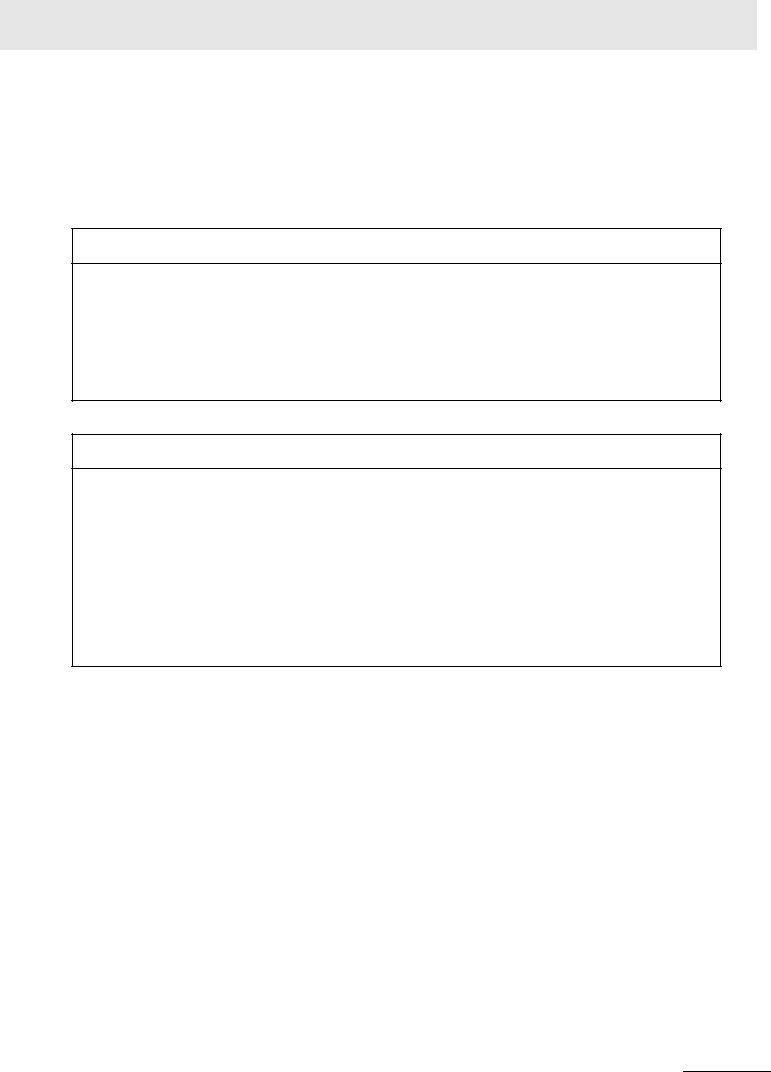
Read and Understand this Manual
Please read and understand this manual before using the product. Please consult your OMRON representative if you have any questions or comments.
Warranty and Limitations of Liability
WARRANTY
OMRON's exclusive warranty is that the products are free from defects in materials and workmanship for a period of one year (or other period if specified) from date of sale by OMRON.
OMRON MAKES NO WARRANTY OR REPRESENTATION, EXPRESS OR IMPLIED, REGARDING NONINFRINGEMENT, MERCHANTABILITY, OR FITNESS FOR PARTICULAR PURPOSE OF THE PRODUCTS. ANY BUYER OR USER ACKNOWLEDGES THAT THE BUYER OR USER ALONE HAS DETERMINED THAT THE PRODUCTS WILL SUITABLY MEET THE REQUIREMENTS OF THEIR INTENDED USE. OMRON DISCLAIMS ALL OTHER WARRANTIES, EXPRESS OR IMPLIED.
LIMITATIONS OF LIABILITY
OMRON SHALL NOT BE RESPONSIBLE FOR SPECIAL, INDIRECT, OR CONSEQUENTIAL DAMAGES, LOSS OF PROFITS OR COMMERCIAL LOSS IN ANY WAY CONNECTED WITH THE PRODUCTS, WHETHER SUCH CLAIM IS BASED ON CONTRACT, WARRANTY, NEGLIGENCE, OR STRICT LIABILITY.
In no event shall the responsibility of OMRON for any act exceed the individual price of the product on which liability is asserted.
IN NO EVENT SHALL OMRON BE RESPONSIBLE FOR WARRANTY, REPAIR, OR OTHER CLAIMS REGARDING THE PRODUCTS UNLESS OMRON'S ANALYSIS CONFIRMS THAT THE PRODUCTS WERE PROPERLY HANDLED, STORED, INSTALLED, AND MAINTAINED AND NOT SUBJECT TO CONTAMINATION, ABUSE, MISUSE, OR INAPPROPRIATE MODIFICATION OR REPAIR.
CJ2 CPU Unit Hardware User’s Manual |
13 |

Application Considerations
SUITABILITY FOR USE
OMRON shall not be responsible for conformity with any standards, codes, or regulations that apply to the combination of products in the customer's application or use of the products.
At the customer's request, OMRON will provide applicable third party certification documents identifying ratings and limitations of use that apply to the products. This information by itself is not sufficient for a complete determination of the suitability of the products in combination with the end product, machine, system, or other application or use.
The following are some examples of applications for which particular attention must be given. This is not intended to be an exhaustive list of all possible uses of the products, nor is it intended to imply that the uses listed may be suitable for the products:
•Outdoor use, uses involving potential chemical contamination or electrical interference, or conditions or uses not described in this manual.
•Nuclear energy control systems, combustion systems, railroad systems, aviation systems, medical equipment, amusement machines, vehicles, safety equipment, and installations subject to separate industry or government regulations.
•Systems, machines, and equipment that could present a risk to life or property.
Please know and observe all prohibitions of use applicable to the products.
NEVER USE THE PRODUCTS FOR AN APPLICATION INVOLVING SERIOUS RISK TO LIFE OR PROPERTY WITHOUT ENSURING THAT THE SYSTEM AS A WHOLE HAS BEEN DESIGNED TO ADDRESS THE RISKS, AND THAT THE OMRON PRODUCTS ARE PROPERLY RATED AND INSTALLED FOR THE INTENDED USE WITHIN THE OVERALL EQUIPMENT OR SYSTEM.
PROGRAMMABLE PRODUCTS
OMRON shall not be responsible for the user's programming of a programmable product, or any consequence thereof.
14 |
CJ2 CPU Unit Hardware User’s Manual |
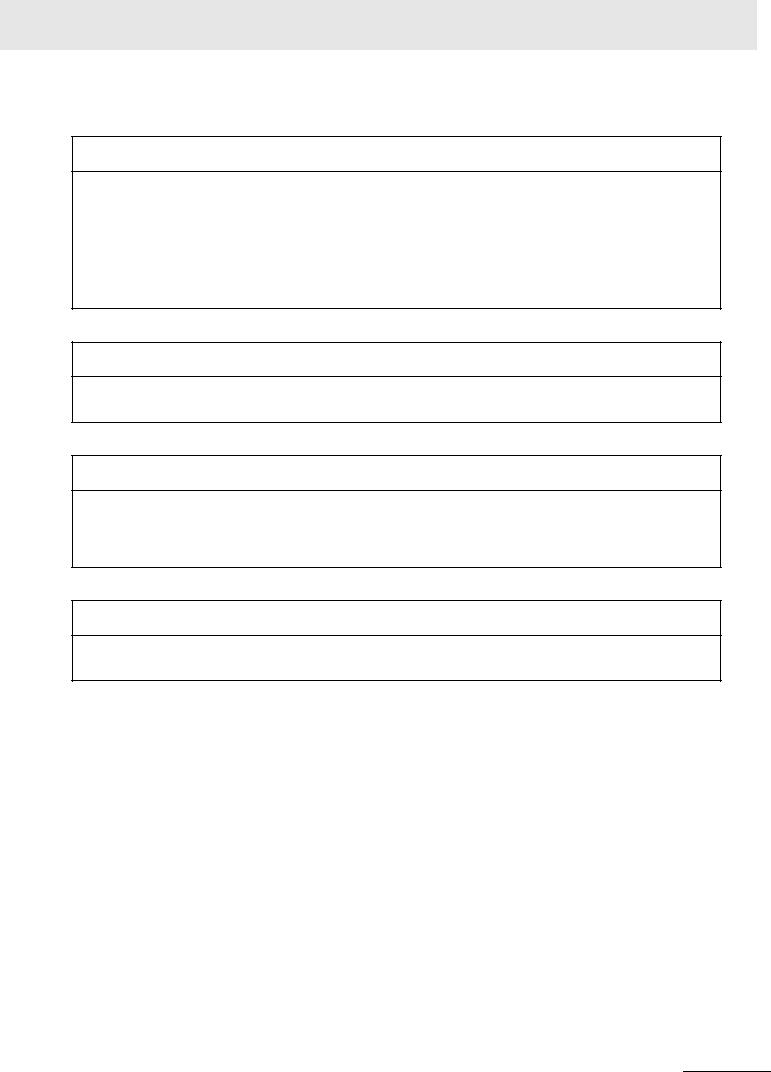
Disclaimers
CHANGE IN SPECIFICATIONS
Product specifications and accessories may be changed at any time based on improvements and other reasons.
It is our practice to change model numbers when published ratings or features are changed, or when significant construction changes are made. However, some specifications of the products may be changed without any notice. When in doubt, special model numbers may be assigned to fix or establish key specifications for your application on your request. Please consult with your OMRON representative at any time to confirm actual specifications of purchased products.
DIMENSIONS AND WEIGHTS
Dimensions and weights are nominal and are not to be used for manufacturing purposes, even when tolerances are shown.
PERFORMANCE DATA
Performance data given in this manual is provided as a guide for the user in determining suitability and does not constitute a warranty. It may represent the result of OMRON's test conditions, and the users must correlate it to actual application requirements. Actual performance is subject to the OMRON Warranty and Limitations of Liability.
ERRORS AND OMISSIONS
The information in this manual has been carefully checked and is believed to be accurate; however, no responsibility is assumed for clerical, typographical, or proofreading errors, or omissions.
CJ2 CPU Unit Hardware User’s Manual |
15 |
|
|
|
|
|
|
|
16 |
CJ2 CPU Unit Hardware User’s Manual |
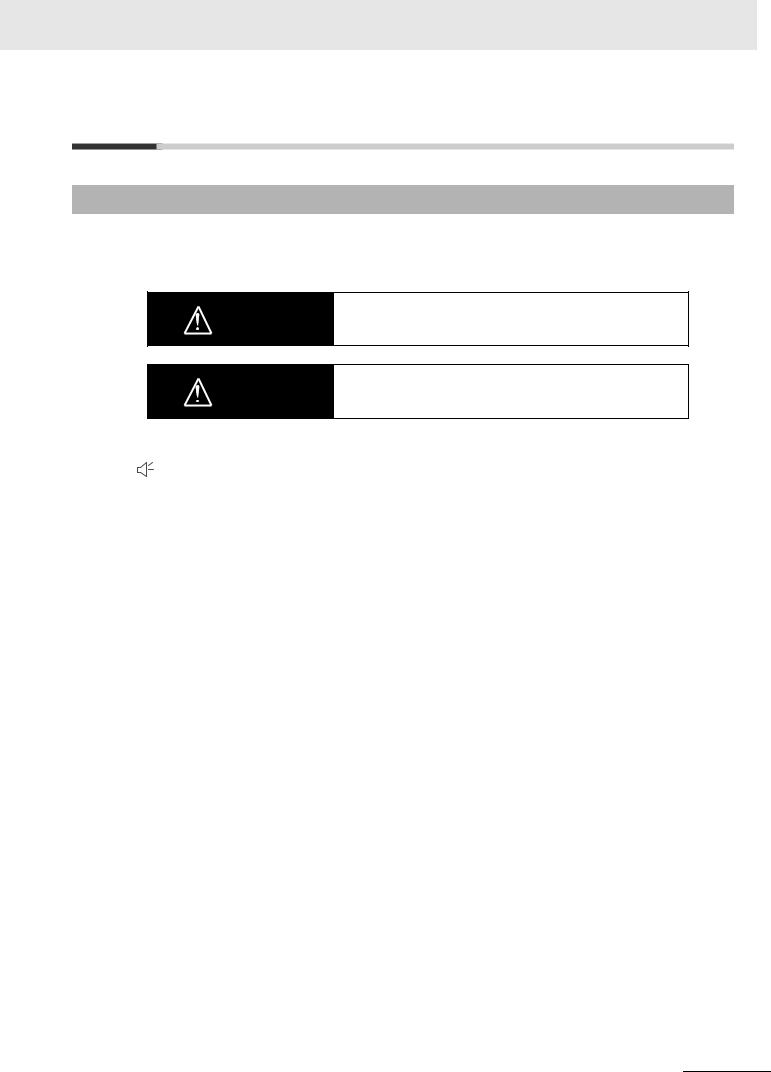
Safety Precautions
Definition of Precautionary Information
The following notation is used in this manual to provide precautions required to ensure safe usage of a CJ-series PLC. The safety precautions that are provided are extremely important to safety. Always read and heed the information provided in all safety precautions.
Indicates a potentially hazardous situation which, if not avoided, WARNING could result in death or serious injury. Additionally, there may be
severe property damage.
Caution
Indicates a potentially hazardous situation which, if not avoided, may result in minor or moderate injury, or property damage.
 Precautions for Safe Use
Precautions for Safe Use
Indicates precautions on what to do and what not to do to ensure using the product safely.
 Precautions for Correct Use
Precautions for Correct Use
Indicates precautions on what to do and what not to do to ensure proper operation and performance.
CJ2 CPU Unit Hardware User’s Manual |
17 |
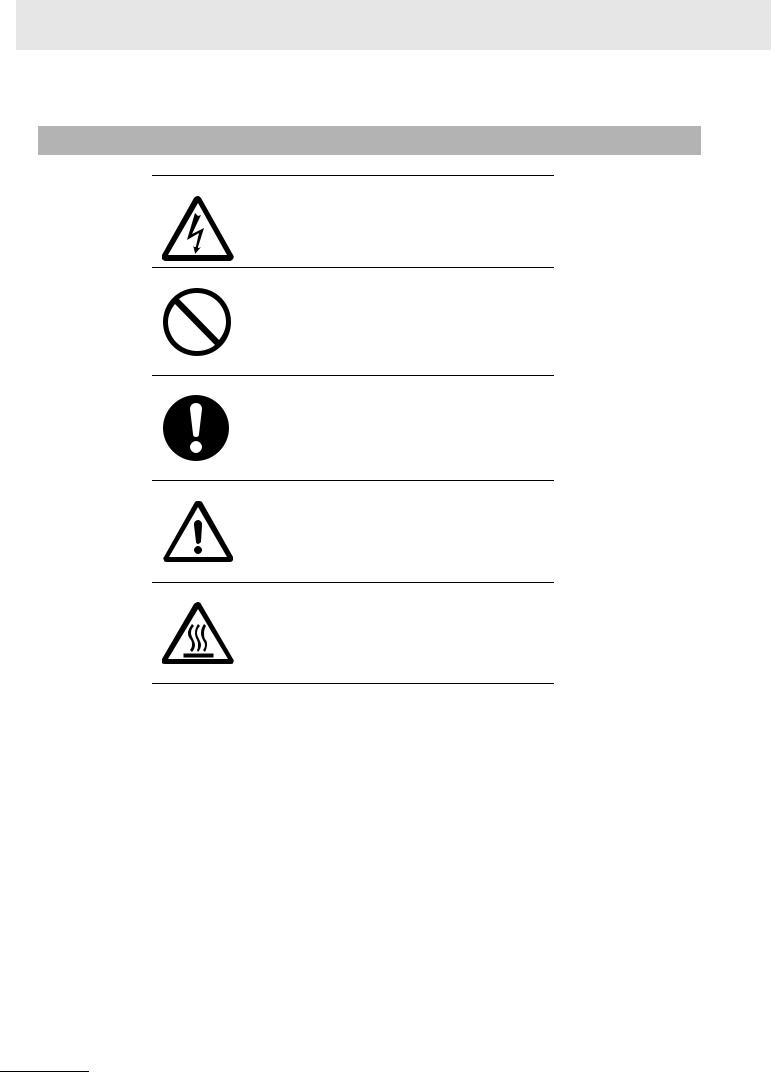
Symbols
The triangle symbol indicates precautions (including warnings). The specific operation is shown in the triangle and explained in text. This example indicates a precaution for electric shock.
The circle and slash symbol indicates operations that you must not do. The specific operation is shown in the circle and explained in text.
The filled circle symbol indicates operations that you must do. The specific operation is shown in the circle and explained in text. This example shows a general precaution for something that you must do.
The triangle symbol indicates precautions (including warnings). The specific operation is shown in the triangle and explained in text. This example indicates a general precaution.
The triangle symbol indicates precautions (including warnings). The specific operation is shown in the triangle and explained in text. This example indicates a precaution for hot surfaces.
18 |
CJ2 CPU Unit Hardware User’s Manual |
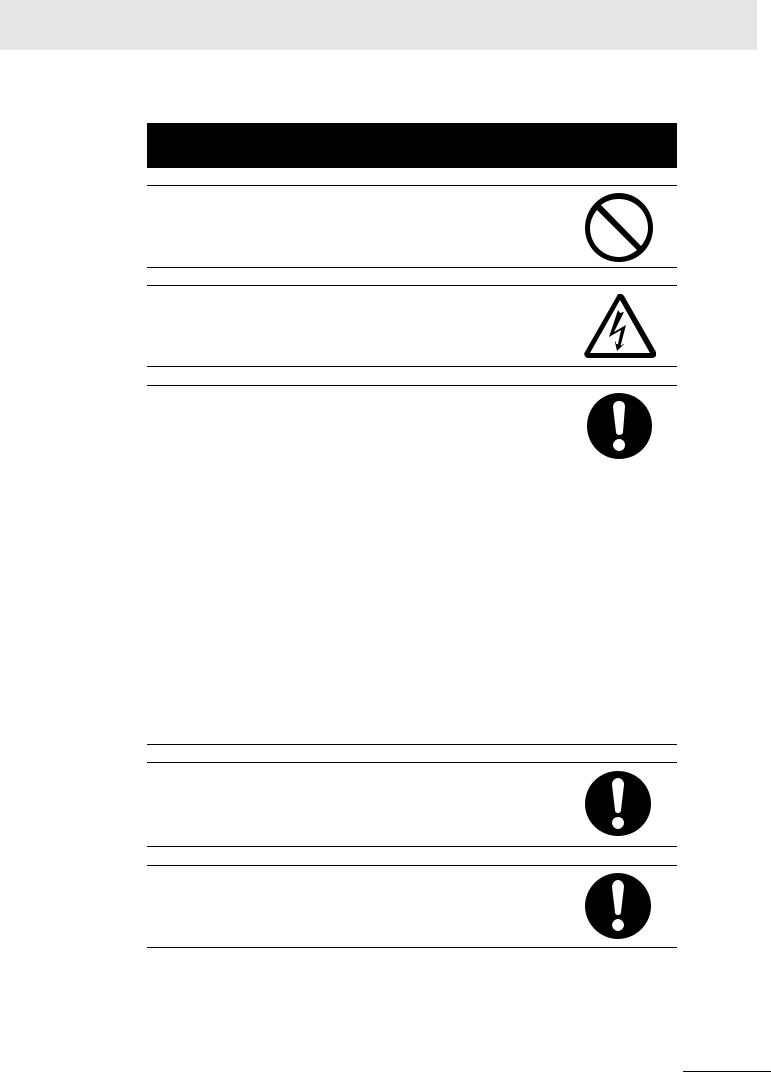
 WARNING
WARNING
Do not attempt to take any Unit apart or touch the inside of any Unit while the power is being supplied. Doing so may result in electric shock.
Do not touch any of the terminals or terminal blocks while the power is being supplied. Doing so may result in electric shock.
Provide safety measures in external circuits (i.e., not in the Programmable Controller), including the following items, to ensure safety in the system if an abnormality occurs due to malfunction of the Programmable Controller or another external factor affecting the operation of the Programmable Controller. “Programmable Controller” indicates the CPU Unit and all other Units and is abbreviated “PLC” in this manual. Not doing so may result in serious accidents.
•Emergency stop circuits, interlock circuits, limit circuits, and similar safety measures must be provided in external control circuits.
•The PLC will turn OFF all outputs when its self-diagnosis function detects any error or when a severe failure alarm (FALS) instruction is executed. Unexpected operation, however, may still occur for errors in the I/O control section, errors in I/O memory, and other errors that cannot be detected by the self-diagnosis function. As a countermeasure for all such errors, external safety measures must be provided to ensure safety in the system.
•The PLC outputs may remain ON or OFF due to deposition or burning of the output relays or destruction of the output transistors. As a countermeasure for such problems, external safety measures must be provided to ensure safety in the system.
•Provide measures in the computer system and programming to ensure safety in the overall system even if communications errors or malfunctions occur in data link communications or remote I/O communications.
Confirm safety before transferring data files stored in the file memory (Memory Card or EM file memory) to the I/O area (CIO) of the CPU Unit using a peripheral tool. Otherwise, the devices connected to the output unit may malfunction regardless of the operation mode of the CPU Unit.
Fail-safe measures must be taken by the customer to ensure safety in the event of incorrect, missing, or abnormal signals caused by broken signal lines, momentary power interruptions, or other causes. Serious accidents may result from abnormal operation if proper measures are not provided.
CJ2 CPU Unit Hardware User’s Manual |
19 |
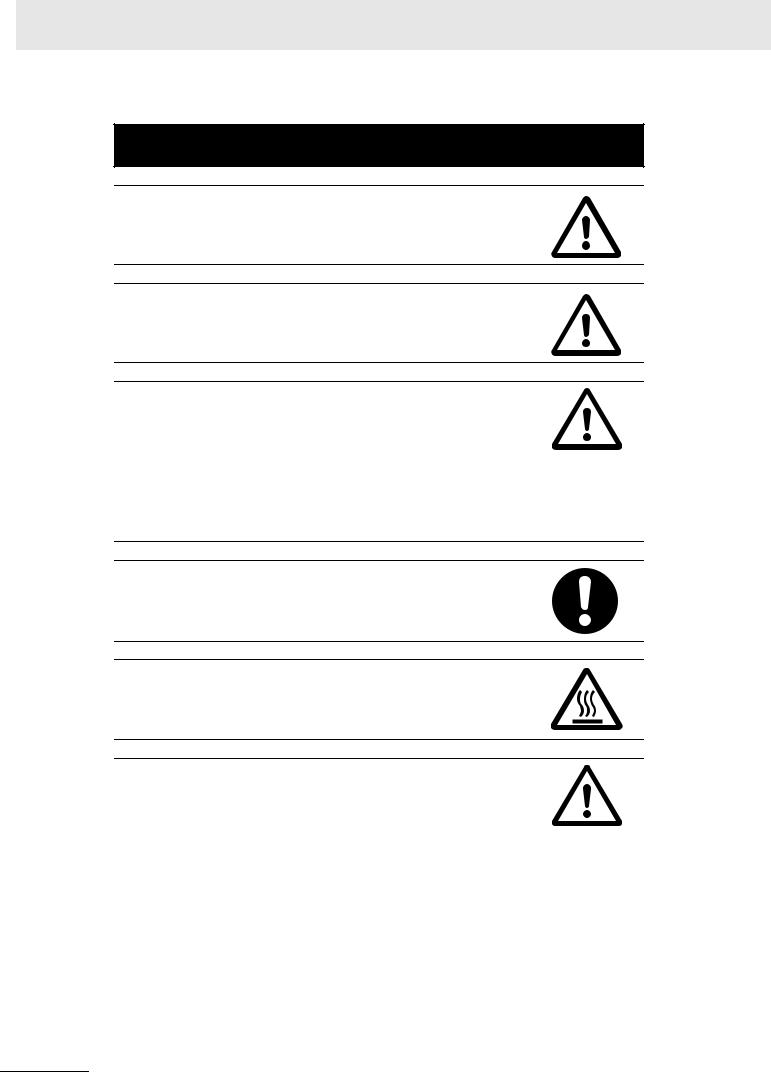
 Caution
Caution
Execute online edit only after confirming that no adverse effects will be caused by extending the cycle time. Otherwise, the input signals may not be readable.
Confirm safety at the destination node before transferring a program, PLC Setup, I/O tables, I/O memory contents, or parameters to another node or changing contents of the any of these items. Transferring or changing data can result in unexpected system operation.
The CJ2 CPU Units automatically back up the user program and parameter data to flash memory when these are written to the CPU Unit. I/O memory including the DM, EM, and Holding Areas), however, is not written to flash memory.
The DM, EM, and Holding Areas can be held during power interruptions with a battery. If there is a battery error, the contents of these areas may not be accurate after a power interruption. If the contents of the DM, EM, and Holding Areas are used to control external outputs, prevent inappropriate outputs from being made whenever the Battery Error Flag (A402.04) is ON.
Tighten the terminal screws on the AC Power Supply Unit to the torque specified in the operation manual. The loose screws may result in burning or malfunction.
Do not touch the Power Supply Unit when power is being supplied or immediately after the power supply is turned OFF. The Power Supply Unit will be hot and you may be burned.
When connecting a personal computer or other peripheral device to a PLC to which a non-insulated Power Supply Unit (CJ1W-PD022) is mounted, either ground the 0 V side of the external power supply or do not ground the external power supply at all ground. A short-circuit will occur in the external power supply if incorrect grounding methods are used. Never ground the 24 V side, as shown below.
Wiring in Which the 24-V Power Supply Will Short
|
Non-insulated |
|
24 V |
DC power supply |
|
|
Peripheral |
|
0 V |
cable |
0 V |
|
FG |
Power Supply |
CPU Unit |
Peripheral device (e.g., |
|
personal computer) |
||||
Unit |
|
|||
|
|
|||
|
|
|
||
|
|
|
|
20 |
CJ2 CPU Unit Hardware User’s Manual |

Application Precautions
Observe the following precautions when using a CJ-series PLC.
zPower Supply
•Always use the power supply voltages specified in the user’s manuals. An incorrect voltage may result in malfunction or burning.
•Exceeding the capacity of the Power Supply Unit may prevent the CPU Unit or other Units from starting.
•Take appropriate measures to ensure that the specified power with the rated voltage and frequency is supplied. Be particularly careful in places where the power supply is unstable. An incorrect power supply may result in malfunction.
•Always turn OFF the power supply to the PLC before attempting any of the following. Not turning OFF the power supply may result in malfunction or electric shock.
•Mounting or dismounting Power Supply Units, I/O Units, CPU Units, Option Boards, Pulse I/O Modules or any other Units.
•Assembling the Units.
•Setting DIP switches or rotary switches.
•Connecting cables or wiring the system.
•Connecting or disconnecting the connectors.
•When cross-wiring terminals, the total current for all the terminal will flow in the wire. Make sure that the current capacity of the wire is sufficient.
•Observe the following precautions when using a Power Supply Unit that supports the Replacement Notification Function.
•Replace the Power Supply Unit within six months if the display on the front of the Power Supply Unit alternates between 0.0 and A02, or if the alarm output automatically turns OFF.
•Keep the alarm output cable separated from power line and high-voltage lines.
•Do not apply a voltage or connect a load exceeding the specifications to the alarm output.
•When storing the Power Supply Unit for more than three months, store it at −20 to 30°C and 25% to 70% humidity to preserve the Replacement Notification Function.
•If the Power Supply Unit is not installed properly, heat buildup may cause the replacement notification signal to appear at the wrong time or may cause interior elements to deteriorate or become damaged. Use only the standard installation method.
•Do not touch the terminals on the Power Supply Unit immediately after turning OFF the power supply. Residual voltage may cause electrical shock.
•Observe the following precautions to prevent failure due to difference in electrical potential if the computer is connected to the PLC.
•Before connecting a laptop computer to the PLC, disconnect the power supply plug of the computer from the AC outlet. Residual current in the AC adaptor may cause difference in electrical potential to occur between the computer and the PLC. After you connect the computer and PLC, supply the power again from the AC adaptor.
•If the computer has an FG terminal, make the connections so that it has the same electrical potential as the FG (GR) terminal on the PLC.
•If the computer is grounded to a separate location, difference in electrical potential may occur depending on the grounding conditions.
zInstallation
•Do not install the PLC near sources of strong high-frequency noise.
•Before touching a Unit, be sure to first touch a grounded metallic object in order to discharge any static build-up. Not doing so may result in malfunction or damage.
CJ2 CPU Unit Hardware User’s Manual |
21 |

•Be sure that the terminal blocks, connectors, Memory Cards, Option Boards, Pulse I/O Modules, expansion cables, and other items with locking devices are properly locked into place.
•The sliders on the tops and bottoms of the Power Supply Unit, CPU Unit, I/O Units, Special I/O Units, CPU Bus Units, and Pulse I/O Modules must be completely locked (until they click into place) after connecting to adjacent Units.
The Unit may not operate properly if the sliders are not locked in place.
zWiring
•Follow the instructions in this manual to correctly perform wiring.
•Double-check all wiring and switch settings before turning ON the power supply. Incorrect wiring may result in burning.
•Be sure that all terminal screws, and cable connector screws are tightened to the torque specified in the relevant manuals. Incorrect tightening torque may result in malfunction.
•Mount terminal blocks and connectors only after checking the mounting location carefully.
•Leave the label attached to the Unit when wiring. Removing the label may result in malfunction if foreign matter enters the Unit.
•Remove the label after the completion of wiring to ensure proper heat dissipation. Leaving the label attached may result in malfunction.
•Use crimp terminals for wiring. Do not connect bare stranded wires directly to terminals. Connection of bare stranded wires may result in burning.
•Do not apply voltages to the Input Units in excess of the rated input voltage. Excess voltages may result in burning.
•Always connect to a ground of 100 Ω or less when installing the Units. Not connecting to a ground of 100 Ω or less may result in electric shock.
A ground of 100 Ω or less must be installed when shorting the GR and LG terminals on the Power Supply Unit.
•Do not apply voltages or connect loads to the Output Units in excess of the maximum switching capacity. Excess voltage or loads may result in burning.
•Do not pull on the cables or bend the cables beyond their natural limit. Doing either of these may break the cables.
•Do not place objects on top of the cables or other wiring lines. Doing so may break the cables.
•Do not use commercially available RS-232C personal computer cables. Always use the special cables listed in this manual or make cables according to manual specifications. Using commercially available cables may damage the external devices or CPU Unit.
•Never connect pin 6 (5-V power supply) on the RS-232C port on the CPU Unit to any device other than an NT-AL001 Link Adapter, CJ1W-CIF11 Converter, and Programmable Terminals (NV3W- M@20L). The external device or the CPU Unit may be damaged.
zHandling
•The Power Supply Unit may possibly be damaged if the entire voltage for a dielectric strength test is applied or shut OFF suddenly using a switch. Use a variable resistor to gradually increase and decrease the voltage.
•Separate the line ground terminal (LG) from the functional ground terminal (GR) on the Power Supply Unit before performing withstand voltage tests or insulation resistance tests. Not doing so may result in burning.
•Make sure that the DIP switches and DM Area are set correctly before starting operation.
•After replacing the CPU Unit, a Special I/O Unit, or a CPU Bus Unit, make sure that the required data for the DM Area, Holding Area, and other memory areas has been transferred to the new Unit before restarting operation.
•Confirm that no adverse effect will occur in the system before attempting any of the following. Not doing so may result in an unexpected operation.
•Changing the operating mode of the PLC (including the setting of the startup operating mode).
•Force-setting/force-resetting any bit in memory.
22 |
CJ2 CPU Unit Hardware User’s Manual |
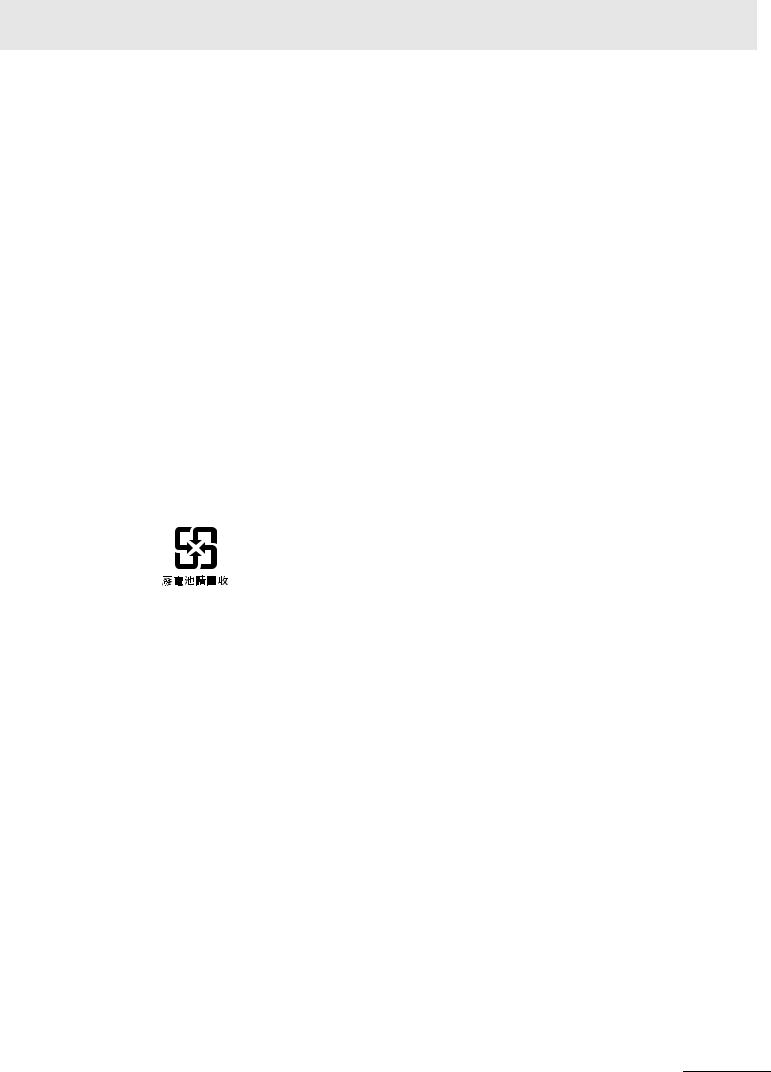
•Changing the present value of any word or any set value in memory.
•Do not attempt to disassemble, repair, or modify any Units. Any attempt to do so may result in malfunction, fire, or electric shock.
•Do not drop the PLC or subject abnormal vibration or shock to it.
•The life of the battery will be reduced if the PLC is left for a period of time without a battery installed and without power supply, and then a battery is installed without turning ON the power supply.
•Replace the battery as soon as a battery error occurs or as soon as the specified battery backup time expires. Be sure to install a replacement battery within two years of the production date shown on the battery's label.
•Before replacing the battery, turn ON power for at least 5 minutes before starting the replacement procedure and complete replacing the battery within 5 minutes of turning OFF the power supply. Memory contents may be corrupted if this precaution is not obeyed.
•If the Battery Error Flag is used in programming the application, confirm system safety even if the system detects a battery error before you replace the battery while the power is ON.
•Do not short the battery terminals or charge, disassemble, heat, or incinerate the battery. Do not subject the battery to strong shocks. Doing any of these may result in leakage, rupture, heat generation, or ignition of the battery. Dispose of any battery that has been dropped on the floor or otherwise subjected to excessive shock. Batteries that have been subjected to shock may leak if they are used.
•UL standards require that only an experienced engineer can replace the battery. Make sure that an experienced engineer is in charge of battery replacement. Follow the procedure for battery replacement given in this manual.
•Dispose of the product and batteries according to local ordinances as they apply.
•If the I/O Hold Bit is turned ON, the outputs from the PLC will not be turned OFF and will maintain their previous status when the PLC is switched from RUN or MONITOR mode to PROGRAM mode. Make sure that the external loads will not produce dangerous conditions when this occurs. (When operation stops for a fatal error, including those produced with the FALS(007) instruction, all outputs from Output Unit will be turned OFF and only the internal output status will be maintained.)
•Unexpected operation may result if inappropriate data link tables or parameters are set. Even if appropriate data link tables and parameters have been set, confirm that the controlled system will not be adversely affected before starting or stopping data links.
•Write programs so that any data that is received for data link communications is used only if there are no errors in the CPU Units that are the sources of the data. Use the CPU Unit error information in the status flags to check for errors in the source CPU Units. If there are errors in source CPU Units, they may send incorrect data.
•All CPU Bus Units will be restarted when routing tables are transferred from a Programming Device to the CPU Unit. Restarting these Units is required to read and enable the new routing tables. Confirm that the system will not be adversely affected before transferring the routing tables.
•Tag data links will stop between related nodes while tag data link parameters are being transferred during PLC operation. Confirm that the system will not be adversely affected before transferring the tag data link parameters.
•If there is interference with network communications, output status will depend on the devices that are being used. When using devices with outputs, confirm the operation that will occur when there is interference with communications, and implement safety measures as required.
CJ2 CPU Unit Hardware User’s Manual |
23 |

•When creating an AUTOEXEC.IOM file from a Programming Device (a Programming Console or the CX-Programmer) to automatically transfer data at startup, set the first write address to D20000 and be sure that the size of data written does not exceed the size of the DM Area. When the data file is read from the Memory Card at startup, data will be written in the CPU Unit starting at D20000 even if another address was set when the AUTOEXEC.IOM file was created. Also, if the DM Area is exceeded (which is possible when the CX-Programmer is used), the remaining data will be written to the EM Area.
•The user program and parameter area data in the CJ2 CPU Units are backed up in the built-in flash memory. The BKUP indicator will light on the front of the CPU Unit when the backup operation is in progress. Do not turn OFF the power supply to the CPU Unit when the BKUP indicator is lit. The data will not be backed up if power is turned OFF.
•Check the user program and Unit parameter settings for proper execution before actually running them on the Unit. Not checking the program and parameter settings may result in an unexpected operation.
•When setting a Special I/O Unit or CPU Bus Unit in the I/O tables, carefully check the safety of the devices at the connection target before restarting the Unit.
•Do not turn OFF the power supply to the PLC when reading or writing a Memory Card. Also, do not remove the Memory Card when the BUSY indicator is lit. Doing so may make the Memory Card unusable.
To remove a Memory Card, first press the memory card power supply switch and then wait for the BUSY indicator to go out before removing the Memory Card.
•When restoring data, carefully check that the selected data is the correct data to be restored before executing the restore operation. Depending on the contents of the selected data, the control system may operate unexpectedly after the data is restored.
•Some Special I/O Units and CPU Bus Units operate with parameters stored in the CPU Unit (e.g., words allocated in DM Area, data link tables, or Ethernet settings). Information on restrictions will be displayed in the Information Area in the PLC Backup Tool if there are any restrictions for the selected CPU Bus Unit or Special I/O Unit. Check the restrictions, and then be sure to select both the CPU Unit and the CPU Bus Unit or Special I/O Unit when backing up or restoring data. The control system may operate unexpectedly if the equipment is started with the data backed up or restored without selecting both Units.
•Information on restrictions will be displayed in the Information Area in the PLC Backup Tool if the data to be stored includes a Unit that has restrictions on backup. Check the information on restrictions and take the required countermeasures. The control system may operate unexpectedly when the equipment is operated after the data is restored
•Before restoring data during PLC operation, be sure that there will be no problem if PLC operation stops. If the PLC stops at an unexpected time, the control system may operate unexpectedly.
•Be sure to turn the PLC power supply OFF and then back ON after restoring data. If the power is not reset, the system may not be updated with the restored data, and the control system may operate unexpectedly.
•Data on forced status can be backed up but it cannot be restored. Perform the procedure to forceset or force-reset bits from the CX-Programmer as required before starting operation after restoring data that includes forced status. Depending on the difference in the forced status, the control system may operate unexpectedly.
•If a symbol or memory address (only symbols are allowed for ST programming) is specified for the suffix of an array variable in ladder or ST programming, be sure that the specified element number does not exceed the maximum memory area range.
Specifying an element number that exceeds the maximum range of the memory area specified for the symbol will result accessing data in a different memory area, and may result in unexpected operation.
•If a symbol or address is specified for an offset in a ladder diagram, program so that the memory area of the start address is not exceeded when the offset is specified indirectly using a word address or symbol.
If an indirect specification causes the address to exceed the area of the start address, the system will access data in other area, and unexpected operation may occur.
24 |
CJ2 CPU Unit Hardware User’s Manual |
